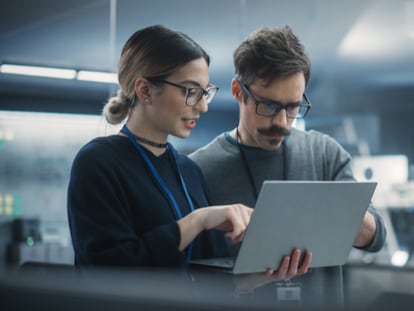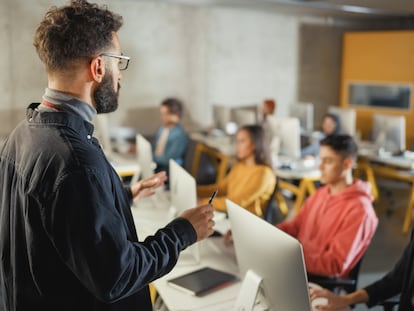An artificial meniscus and 371 days of swallowing toothpaste: Frank Rubio’s adventures in space
The NASA astronaut speaks with EL PAÍS about the mission in which he broke the record for the longest stay on the International Space Station
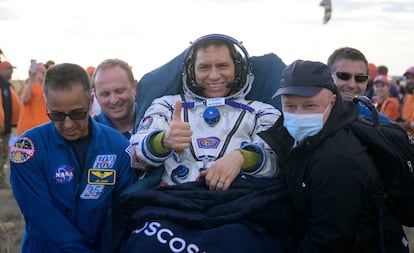
He spent a record 371 days on the International Space Station (ISS) and — with his dedication and medical knowledge — contributed scientific research that, in a couple of decades, could provide human beings with artificial organs manufactured under conditions of weightlessness. Francisco “Frank” Rubio is a 48-year-old Los Angeles-born doctor and American soldier of Salvadoran descent. He has logged more than 1,100 flight hours as a Blackhawk helicopter pilot. He’s also an accomplished parachutist, having completed more than 650 free-fall jumps.
In 2022, Rubio was assigned a six-month-long mission to the ISS, but ended up stranded due to a breakdown in the cooling system of the Russian Soyuz MS-23 spacecraft, on which he had to return to Earth. Hence, he ended up staying on the ISS for more than a year, longer than any other NASA astronaut. As a doctor, he knew the toll that this feat would take on his body: in space, bone density is lost more quickly, due to the absence of gravity. This can also affect the immune and cardiovascular systems.
Military training, Rubio explains, helped him face the psychological challenge of a prolonged stay in space. Before joining NASA, he served on missions in Bosnia, Afghanistan and Iraq. In 2017, he was selected by the U.S. space agency and spent two years in intensive training before his first special mission.
On the ISS, the astronaut decided to focus on what he loves most: medicine. He worked on hundreds of experiments. One of his favorites took place in the BioFabrication Facility (BFF) — a 3D biological printer — where he participated in research evaluating the mechanical properties of a meniscus that was printed with biological cells and inks. “We were learning about how cells behave in microgravity and how they [divide themselves]. It’s a little different, because the shape of the cells can be maintained a little more easily [in zero-gravity],” he explains in Spanish from NASA, in a brief video call with EL PAÍS.
“While I was there, we were able to make a piece of the meniscus… that’s incredible. And that’s because microgravity leaves us. On Earth, it couldn’t be done, because there’s too much gravity. And now, what we have to discover is how to [replicate the full] meniscus and how to maintain the structures of those tissues on Earth.” According to Rubio, if this type of research continues to advance, complete organs — such as a heart or a liver — could be manufactured in space within 10 or 20 years.
The experiment — which he worked on with NASA colleagues Warren Hoburg and Stephen Bowen and Emirati astronaut Sultan Al Neyadi — could have a huge impact on the quality of life of thousands of people if it’s implemented in real-life scenarios. To give an example, more than 50 of every 100,000 people suffer from acute meniscal tears each year.
Biomanufacturing in space can be more productive due to the absence of gravity. Among the medical applications that could be developed under these conditions is the mass production of stem cells, the creation of advanced models of diseases, or the expansion of 3D bioprinting capabilities. Additionally, this branch of biotechnology could contribute to the creation of new sustainable materials for fashion, sports, or construction.
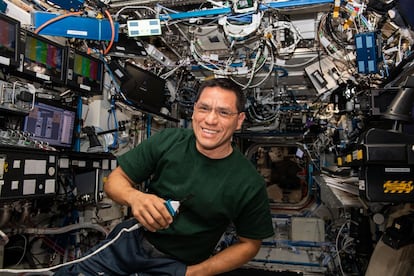
During one of his three spacewalks, Rubio also helped install a device designed for the deployment of small satellites. Furthermore, on the ISS, he participated in growing hydroponic vegetables. He was even unfairly accused by his colleagues of eating a couple of tomatoes that had been placed in a bag (they actually ended up floating in the ducts of the space complex). He was only exonerated when — months later — other astronauts found them when he was already back on Earth. Learning to grow crops in water or air will depend largely on how the space race goes in the future.
The daily challenges of living in space
Rubio had prepared himself to spend six months in space, which is usually how long a NASA mission lasts. There are exhausting responsibilities for whoever decides to do it. However, he ended up staying there for more than a year, which made him the U.S. agency’s astronaut to have spent the most time on the space station. He surpassed Mark Vande Hei, who spent 355 consecutive days on the ISS.
EL PAÍS asks Rubio if he missed Earth more when he was stranded on the ISS, or whether he misses the station more now that he’s back here.
“When I was there,” he replies, “every day, I missed my family and I missed the house. But now that I’m here — four months after returning — at least once a week, I think that I would like to be there again for at least a few hours, to enjoy the view, to enjoy floating. Being part of a complete space mission is something very special and I miss it a little,” he admits.
Of course, he doesn’t miss it all the time. Rubio assures EL PAÍS that daily routines in space are less glamorous than we imagine. The astronaut spent a full year isolated from the world, floating, without eating fresh food, without hugs from family or going for walks. He spent the day working up to nine hours on high-level research investigations, in which there’s no room for error. He also had to do substantial maintenance and training tasks.
There were intense days, he says, in which — among other things — the astronauts received continuous solar radiation and lost muscle mass, even though they exercised for two hours a day. “It takes a couple of months to get used to that rhythm,” he explains. Furthermore, Rubio recalls that he missed seeing water flow. Astronauts wash themselves with wet towels, while they brush their teeth with their mouths almost closed, so as to prevent any liquid from dissipating throughout the station and contaminating other rooms where research is carried out. Once used, toothpaste can be spit out onto a cloth, but he chose to swallow it. “I swallowed that twice a day for a whole year,” he confesses, laughing. “It’s part of the operation.”
The space race has made several generations idealize the work of astronauts, men and women who risk their lives for science. However, while the view from space is spectacular, the emotional, physical and work load is difficult. “I believe that every day of the 370 that I spent in space was special. Every day, there was a spectacular image that added to the beauty of the entire experience of being there,” he says.
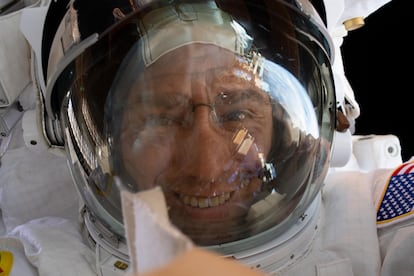
For him, the biggest challenges in space are biological: adapting to life without gravity. And, although some business magnates claim to have inaugurated the era of space tourism, Rubio believes that humans aren’t yet ready for long space stays, which last for more than one or two years. According to NASA estimates, with the current technology, a round trip to Mars could take three years, while a trip to Pluto could take up to 40. Although, the astronaut clarifies, “what seems impossible today will one day be normal.”
“I believe that, psychologically and physically, there are people who can make the effort, and those types of people are the ones needed to advance the space race now,” he affirms. It’s a task that requires “a lot of strength” and a good team. “It’s very important to have a strong family, a strong community that supports you, [so that you can] be successful,” he emphasizes.
Rubio feels privileged to be part of an advanced mission “that’s advancing science and technology and doing things to make life better for all of humanity.” The love for this job makes him want to continue for a few more years. “And, God willing, maybe return to space for much more time.” 371 days weren’t enough for the NASA astronaut who has spent the longest consecutive amount of time on the ISS.
Latinos in space
There are 15 astronauts of Hispanic origin who have traveled to space with NASA or its allies. These are some of them:
- Arnaldo Tamayo Méndez, from Cuba, was the first person of Hispanic origin to travel to space, in 1980.
- Rodolfo Neri Vela, from Mexico, was the first Latino to fly on an American space shuttle, in 1985. He also introduced tortillas to the astronauts' menu.
- Franklin Chang-Díaz, originally from Costa Rica, became the first Hispanic-American in space, in 1986. He holds the record of having traveled to space seven times.
- Ellen Ochoa, of Mexican origin, was the first female Hispanic astronaut, in 1993. She was also the first person of Hispanic origin to direct NASA's Johnson Space Center.
- José Hernández, whose parents were immigrants from Mexico, became the first astronaut to use Twitter in Spanish from space, in 2009.
Sign up for our weekly newsletter to get more English-language news coverage from EL PAÍS USA Edition
Tu suscripción se está usando en otro dispositivo
¿Quieres añadir otro usuario a tu suscripción?
Si continúas leyendo en este dispositivo, no se podrá leer en el otro.
FlechaTu suscripción se está usando en otro dispositivo y solo puedes acceder a EL PAÍS desde un dispositivo a la vez.
Si quieres compartir tu cuenta, cambia tu suscripción a la modalidad Premium, así podrás añadir otro usuario. Cada uno accederá con su propia cuenta de email, lo que os permitirá personalizar vuestra experiencia en EL PAÍS.
En el caso de no saber quién está usando tu cuenta, te recomendamos cambiar tu contraseña aquí.
Si decides continuar compartiendo tu cuenta, este mensaje se mostrará en tu dispositivo y en el de la otra persona que está usando tu cuenta de forma indefinida, afectando a tu experiencia de lectura. Puedes consultar aquí los términos y condiciones de la suscripción digital.
More information




